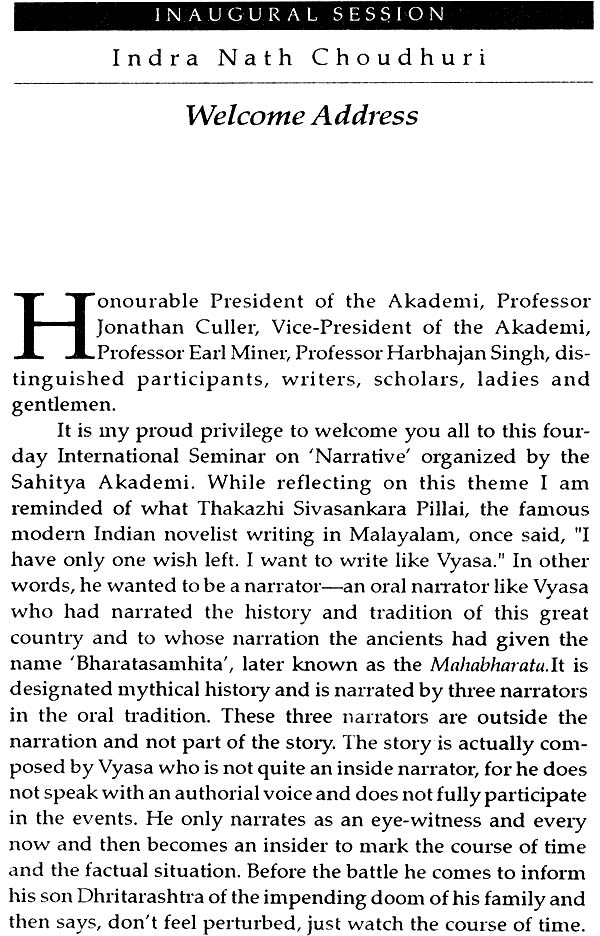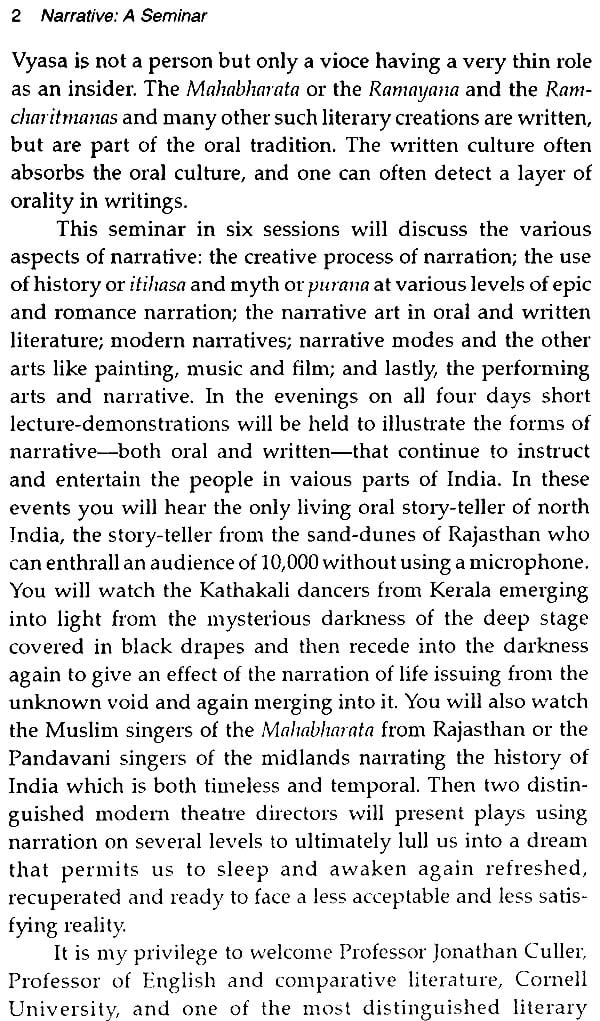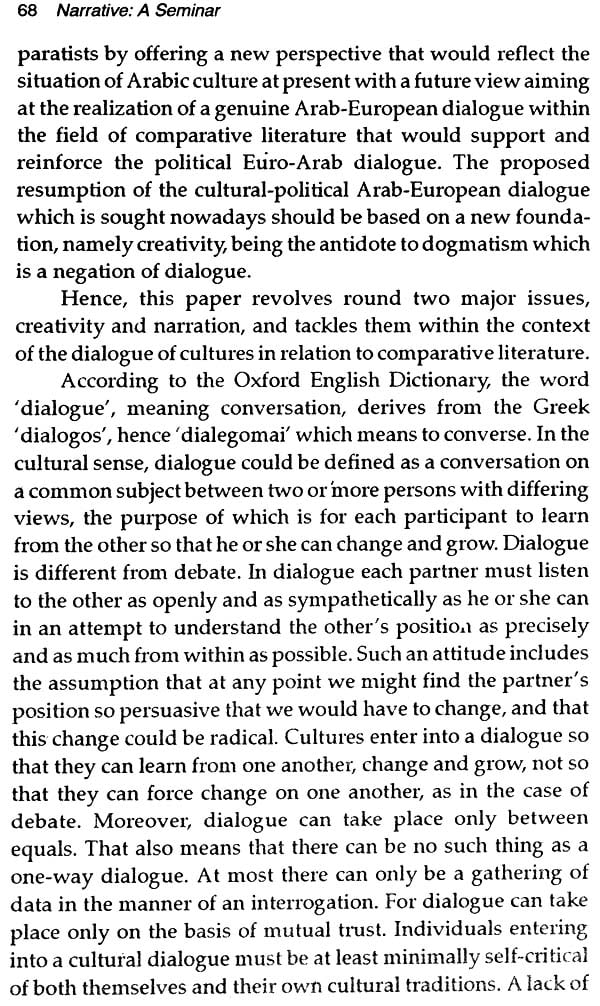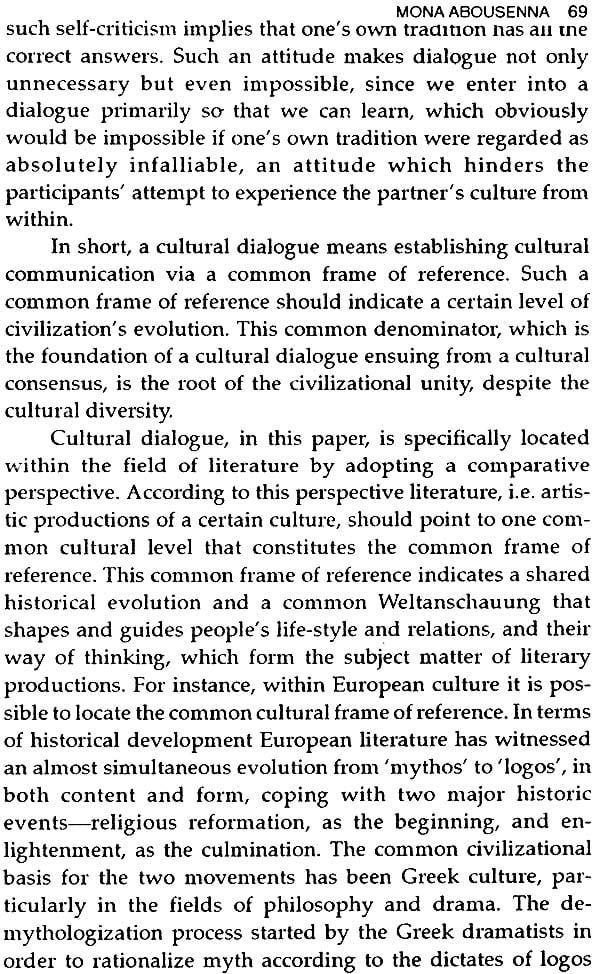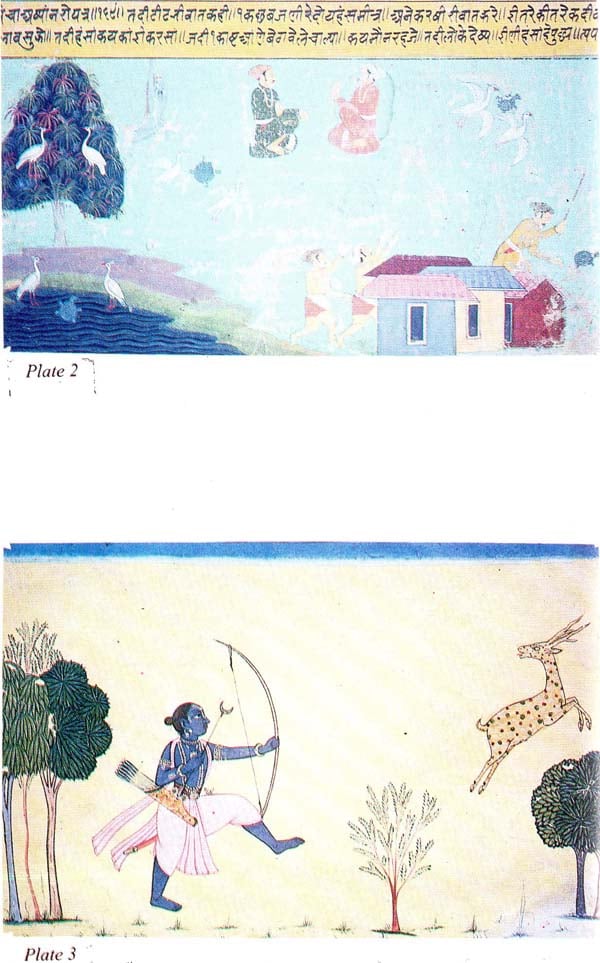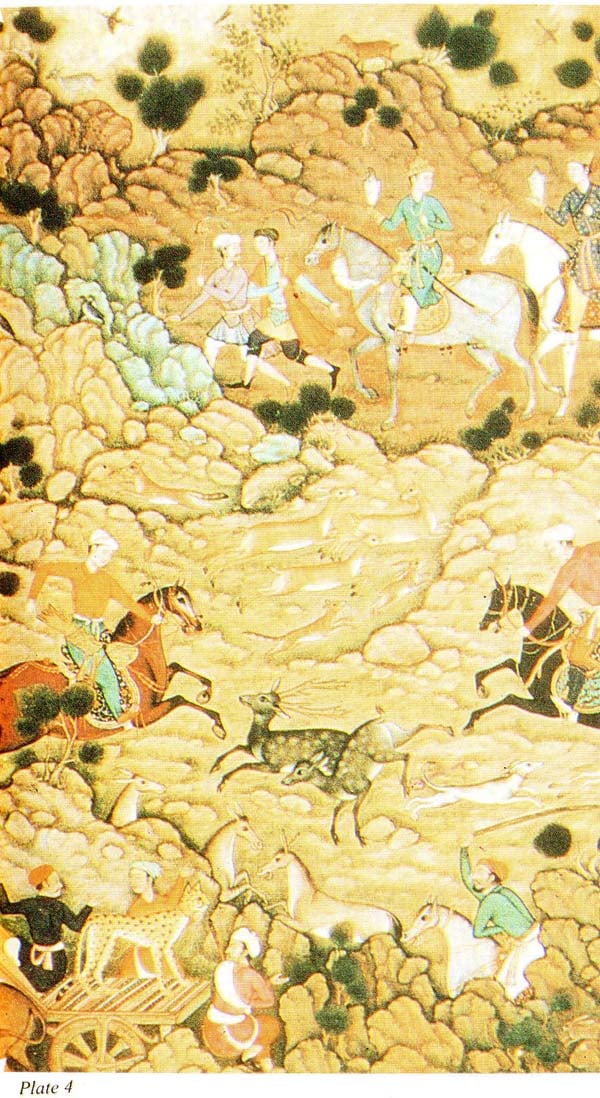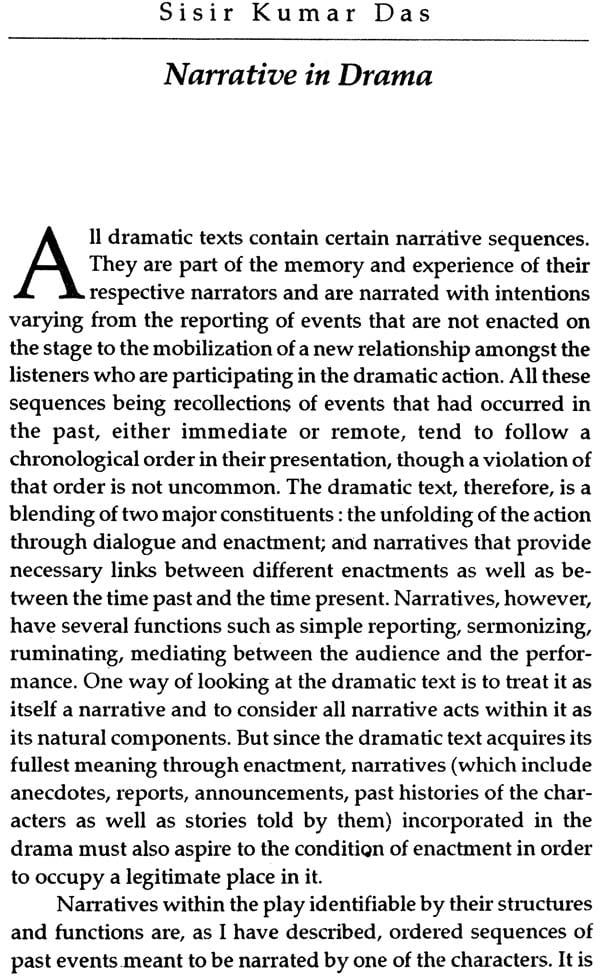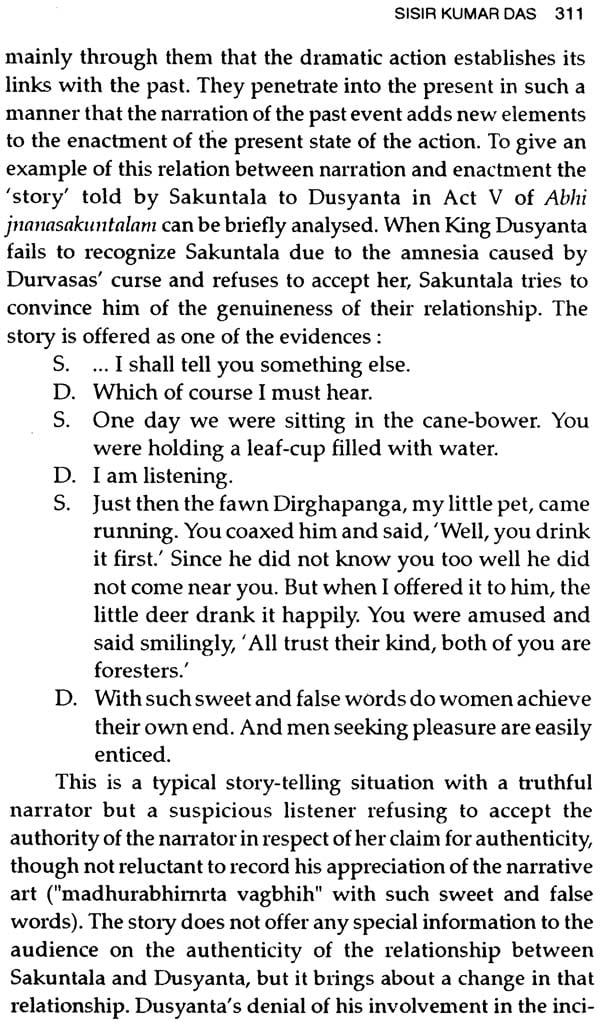
Narrative: A Seminar
Book Specification
| Item Code: | NAQ548 |
| Author: | Amiya Dev |
| Publisher: | SAHITYA AKADEMI, DELHI |
| Language: | English |
| Edition: | 2017 |
| ISBN: | 9788172017804 |
| Pages: | 354 |
| Cover: | PAPERBACK |
| Other Details | 8.50 X 5.50 inch |
| Weight | 500 gm |
Book Description
Narrative A seminar is a collection of papers presented at the international seminar on narrative held by Sahitya Akademi in 1990. The discussion here cuts across a number of languages, genres, art forms and historical periods. The participants are celebrated scholars and writers Jonathan culler, harbhajan Singh, Earl Miner, Birendra Kumar Bhattacharyya, Holger Klein, Bhisham Sahni, RamchndraGandhi, Mona Abousenna, Douwe Fokkema, ania Carvalhal, Sitaknat Manhapatra, Vidya Niwas Misra, Milan V. Dimic T. Morimoto, Suresh Awasthi ,Nabaneeta Deba Sen, Fridrun Rinner , Milan Djurcinov, Qurratulain Hyder, Maria Seixo, Karl Maures, Yves Chevrel, John Neubauer, Rai Anand Krisha, Bhaskar Chandravarkar, Gerald Gillespie, N.C. Jain, Sisr Kumar Das, Ashok Ranade and Amiya Dev. The volume in six parts beginning with the first hand testanebt if creative writers, moving on to oral and written narratives of the past, modern fictional narrative, painting, music, film and theatre, is a major contribution to thetheory and practice of Narratology a must for academics and interest readers, a pride for libraries. Amiya Dev(b,1935) the editor of this volume is former Vicechancellor of Vidyasagar University and also former professor and dean, Faculty of Arts, Jadavpur University and editor of the jadavpur Journal of Comparative Literature in India and a monograph on Sudhindranath Datta, Besides coediting comparative Literature , Theory and Practice with Dr. Sisir Kumar Das. He has also contributed several scholary papers on Comparative Literature.
The paper printed here were present at an international seminar on narrative held in New Delhi on 22-25 February 1990 under the auspices of sahitya akademi as a part of its annual festival of letters. They appear in their order of presentations and in sections into which the seminar was divided. The discussion they fetched was most alive were the introductory and concluding remarks by the sectional chairpersons, also untranscribed. what is recorded here is what was available in script - twenty- eights paper apart from the vote of thanks by the akademi secretary and vice - perish dent respectively , the presidential address , two keynote addresses, by an Indian and an overseas expert , and the inaugural address itself.
The seminar was conceived as an exercise in comparative literature cutting across a number of languages, historical periods, genres and art forms. The participants were writers as well as scholars same both. however , the overseas participants were primarily scholars from counters as varied as Austria , Britain , Canada , Egypt , France , Germany , Japan Netherlands, Portugal and USA; and although the Brazilian and the jugoslav participants could not finally come they had sent their paper . The only overseas participant who could not come and whose paper is not here is Ziva ben porat of tel Aviv university , Israel . we also missed U.R Ananthamurthy , the kannada writer and persent president of the Akademi, then vice - Chancellor of Mahatma Gandhi university , kot -tayam . The seminar was transacted in the India International centre auditiorium and was the well attended. Among participants who did not presents paper were well attended . Among participants who did not present were attended , among participants who did not not present papers were many including some from overseas, from Canada , china , denmarkes , hungary , korea and USA . The transactions were complemented in the evening by narrative performances. from various parts of India - the dastan rescitation and kathakali from the south , a Bengali play based on a popular ballad and a kannada stage adaptation of literary narratives . the dastan traditions was introduced by qurratulain hyper , the kudiyattam and kathkali by ayyappa paniker and the Bhagawat singing by komal kathari . the Bengali plays was directed by bibhas chakrabarty and the kannada productions by B.V Karanth.
AS the structure of the volume shows , the seminar was conceived in six parts each dealing with a particular aspect of the art of narrative . we began with the creator himself a narratives and tried to gather his testament . that two of the participants invited here were fictions writers of great reputes (though one could not come) was no coincidences . From there we moved on , on the the one narratives , primarily the novel and shorts story . but we did not stops with the verbal forms alone of narrative, whether old or new , whether distant or familiar , whether old or new whether distant or familiar , whether instantly or leisurely compased ; we also tougher of the other arts . In part five the focus was on the place of narrative in the films and in part six we turned in the first place to theatre and in the second to what can perhaps be called a passable be called a passible narratology of performance.
The tone was set for the seminar in the inaugural session where repeated reference was made to the Mahabharata. Indra Nath Chaudhuri reminded us of what the famous Malayalam novelist Thakazhi sivasankara pillai had reportedly said about his one last inaugural discourse with a reference to shashi Tharoors’s adaption of the mahabrata . In his referectiones on narratology birendra kumar bhattarcharya spokes again and again of the Indian tradition with Mahabharata at the head. And Gangadhar Godgil confessed that like everyone else’s his words too were here Mahabharata inspired . Indeed if there was one text that become the refrain of the whole seminer that was the Mahabharata. It was as if the seminar was on a tryst with that spirit which persuaded ramchandra Gandhi begin his discourse on the mahabhrata under epics and romances with a nightmarish visions of postwer devastation?
The Mahabhrata has three sets of narratee built into it, the fellow sages of naimisa , king janamejaya and , for a part , the blind king Dhritarastra . they are all essential to the whole Mhabharata is addressed is said to be attaining piety by listening . If narrate matters that much in narrations alone all we can hope is that much in nattation , then we are doing a half job by transcribing the seminar’s narrators alone. All we can hope is that our readers will recreate the narration situations. As to the piety that is to follow from such recreation, we surely are no judges.
I am grateful to the Sahitya Akademi for giving me a chance to reread these papers . All I have can hope is the our readers will recreate the narrations situations. As to the piety that is to fallow from such recreation, we surely are no judges. I am grateful to the is to follow from giving me a chance to reread these papers these paper. All I have done by way of editing is dot the i’s and cut the give uniformity to such spellings as ‘favour’ and ‘favour’ ‘analyze’ and ‘judgement’ and ‘judgment ’ . and ‘western’ as an adjective has been spelt with both a capital and small ‘w’ depending on the weight attached . uniformity in footnote / endnote style is well night impossible , for some go by the more recent markers of author , year and page number on the basis of initial reference in the body of the text or in a separate bibliography , while other still stick to by -now -antiquated erasure of publisher . I have put all commas and full stops outside quotations when they are not part of it.
Acknowledgments are due to many. First to the participants in the narrative seminar, including those in absentia, whose paper make up this volume. Next the publications unit of Sahitya Akademi’s new Delhi office for putting the scripts together and for helping in every way to give the volume as complete office for preparing the finally the akademi’s Calcutta office for preparing the final typescript and transcribing a text out of a magnetic tape . Acknowledgements are also due to may have been . If this volume ears any credit it goes to them all - the akademi and the contributors. Its lapses are all mine.
